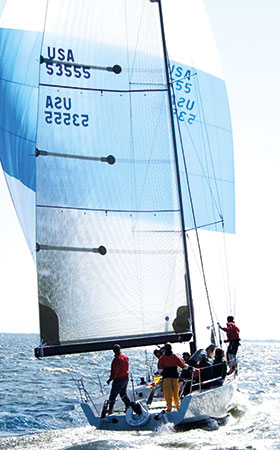

A racing yacht is an unlikely place to find one of the world’s most advanced hydraulic servo valves. Traditionally used to synchronise motion in large industrial machines in steel plants and automotive presses, the Moog axis control valve (ACV) is an intelligent closed-loop motion control device that closes the control loop right in the valve and offers some of most advanced functionality for critical machinery. This may be the first time Moog knowhow has been applied to win races on the high seas.
An innovative advantage
Inspiration and innovation led Dr Dick Aubrecht, Moog’s vice president strategy and technology, and an experienced engineer and sailboat racer, to install an ACV on the Veloce, his 11 m, 2500 kg Farr 11S sailboat. Aubrecht had always admired the 22+ m boats that compete in the Volvo Ocean Race, among the first vessels to employ a canting keel. This type of ballast moves laterally to keep a sailboat’s mast and hull at the best angle relative to the water’s surface during a race.
Like the Volvo racers, the Farr 11S boats have a hydraulically actuated canting keel. The angular movement of Veloce’s keel is 45° to both port and starboard. All sailboats heel due to the force of the wind on the sails. A traditional, or non-canting keel, remains in a fixed vertical position to resist waves and water, and maintain the boat’s stability. A captain with a traditional keel will deploy the crew at times to the windward side of the boat to add righting moment. With the canting keel to provide righting moment with much less total weight, Veloce can increase its speed by 20 to 100% compared to a conventional yacht of the same size.
Taking a new tack
Aubrecht saw the advantages of the canting keel as well as the possibility to improve its operation, increase safety and enable him to focus on the race. The initial control system for Veloce’s canting keel was open-loop using a solenoid valve, which the captain controlled with on-off switches. Without feedback, it was challenging to know exactly the keel’s position. The user interface for controlling the keel consisted of two buttons, which simply switched the directional solenoid valve and didn’t incorporate a visual indication of the actual keel position.
By replacing the solenoid valve with a Moog ACV proportional valve, Aubrecht can smoothly trim the canting keel to a specific angle in a single motion. The Moog ACV offers advantages over a typical proportional valve because it incorporates motion control electronics integrated within the valve itself. Aubrecht’s customised solution consists of the ACV, Moog valve configuration software, feedback transducer and a user interface. The customised user interface simply consists of a ball on a line. It provides both the command signal input and a visual indication of the keel position. This enables any crew member to exactly set the keel’s position.
Meeting the need for speed
According to Aubrecht, the ACV valve-based system was easy to install and is ideal for the marine environment with its inherent problems of water ingress and electrical interference. The ACV also is more compact than the original system, which included separate PLC electronic controller and interconnecting wiring. Eliminating both components and wiring is particularly important in this application because space is at a premium on a sailboat. The ACV system also provides a dramatic improvement in the smoothness of control.
Being able to set the angle of the keel and turn his focus to racing tactics means Aubrecht can trim the boat faster and more precisely, saving critical seconds in a race. Importantly, the Veloce’s system also includes a home mode, or fail safe, so the canting keel can be driven back to the conventional vertical position in the event of an electrical failure.
Veloce isn’t the only sailboat to make use of Moog technology. In fact, one of the current America’s Cup racing teams uses the Moog E242 sub-miniature cartridge direct drive hydraulic proportional valve.
Flexible performance for machine designers
The Moog axis control valve offers the most advanced functionality for machine designers, including decentralised control, remote diagnostics and machine optimisation. It delivers high performance in applications such as metal forming machinery and presses, test and simulation equipment and gas turbines. As businesses seek to leverage the Internet of Things, remote monitoring and diagnostics incorporating ACVs are transforming commissioning and maintenance.
For more information contact Willie Steyn, Moog, +27 (0)12 653 6768, [email protected], www.moog.com
© Technews Publishing (Pty) Ltd | All Rights Reserved